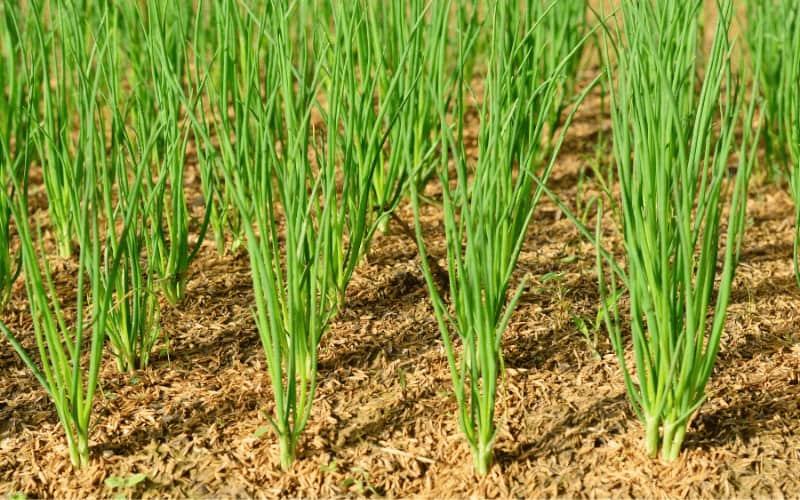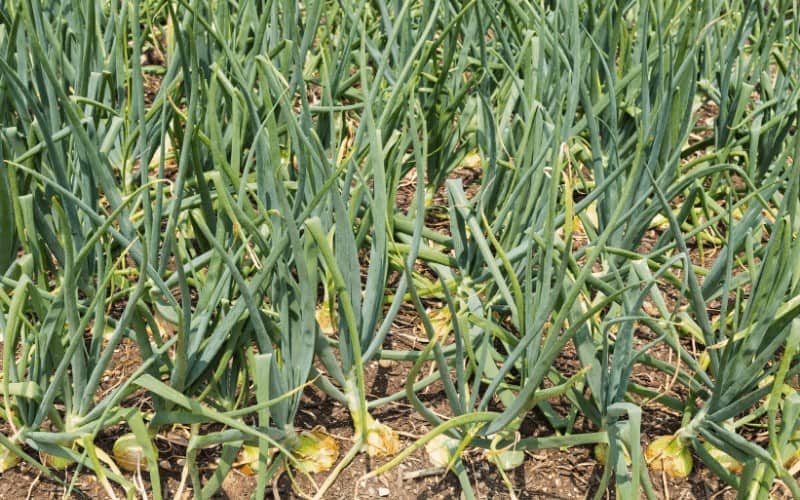You do not need seeds to grow onions if you already have onions in hand. Unlike what most people believe, onion is a vegetable.
It is cultivated and used globally as food. Onions are also used for skin and hair products, weight loss, and has other health benefits.
Knowing how to grow onions from scraps is an invaluable skill for every gardener. The layers of onions are white. They also have a powerful and deep smell.
The deeper the layer of onions, the greater its smell. Onions are one of the popular vegetables out there but can you grow onions from scraps? YES, you can, and we will show you how below.
Table of Contents
How To Grow Onions From Scraps

In contrast to most vegetables, Onions is a very resilient vegetable. Just by keeping onions in your home, you will notice how hard it tries not to spoil or rotten.
Items Needed for Growing Onions In Scraps
- Onion Scraps: Onion scraps are gotten from cooking remains or by chopping onions, as described in the steps for growing onions.
- Watering Can: For watering the onions.
- Compost: To improve nutrients in the can.
- Others include a trowel, rake, string, etc.
Below are steps on how to grow onions from scraps;
1. Select the onions for use
When selecting onions, make sure to pick ones that do not look dehydrated and excessively dry.
Make sure that the onions have little to no cuts on the outer layers. You can also use part of the onion's leftover from cooking as long as the bottom-out part is still intact.
2. Cut the onions
After peeling the last layers of the onions and cutting off the bottom, place it on your chopping board.
You can slice about 2 cm from the bottom. You should keep the bottom-out part of the onions, as it is the part you need for planting.
3. Give the onion bottom-out time to dry
You should lay the onions with the cut side facing upwards. Leave for not less than 24hours, which will give it sufficient time to dry. If it doesn't seem to be drying, place it on a where there is sunlight exposure.
4. Prepare the scrap
You need tiny pointy sticks, or preferably, toothpicks. Use four of these sticks to poke the onions. The sticks should be equally spaced and cross over like the letter X.
5. Fill a small bowl with water and hang the onions over it
Place the onions so that the sticks hold the bowl's corners. The onions bottom-out should fully rest in the water, while the rest of the onions does not.
Leave for 3-4 days. Remember to place the bowl where there is sufficient access to sunlight.
6. Prepare the soil
Place well-draining soil into a garden pot with holes under it. Make sure the soil does not go past halfway. The soil must be fertile and rich in compost.
7. Cultivate the onion scrap
You should place the onion scrap into the garden pot, then fill up the rest of the garden pot with soil. After that, water the plant.
Best Season To Grow Onions

During the early part of their growth, onions require cool weather to grow. At this stage, the best season is spring, when the weather is not too hot or cold.
Plant the onions outdoors where the atmosphere is cool, not freezing. There should also be adequate sunlight exposure.
Best Soil For Planting Onions
Onions are capable of growing in any soil, whether; Sandy, Loamy, or Clay soil. The ground should be bound and well-draining.
The onion plant requires acidic soil to develop. To increase the pH of the earth, you can add limestone to the soil. You should also add compost to make the soil fertile.
Frequently Asked Questions
How do I water my onion plant?
One important thing to know about watering onions is that you should avoid watering the plant itself. Instead, water the soil and help to prevent fungus and bacteria from growing around it.
Water sprinklers are better options for watering onions. It is better to underwater your onions than to overwater them. Overwatering leads to a diseased and rotten plant.
What type of onions is best to plant?
You can easily use the type of onions used for cooking in your home. There are various varieties of onions.
Some of them include; White Onion, Bunching Onions, Calcot, Potato Onions, Walla Walla, etc.
How do I protect my onions from pests and diseases?
Immediately you notice any of your plants are rotting, pull them out and throw them in the garbage. Once every week, look around your onions to see can see any signs of rotting.
Good fertilization of your onions and keeping the onions away from moisture will help manage pests.
The soil should be watered, not the plant itself. Some onion pests include; Onion Maggots, Thrips, Black Mould, Purple blotch, etc.
Related Posts:
- When to Plant Onions in Alabama
- How To Grow Cauliflower From Scraps
- How to Grow Turnips From Scraps
- Is Mushroom A Vegetable
Conclusion
It is ill-advised to grow onions in places where the weather is freezing. In learning how to grow onions from scraps, you should know that onions require adequate sunlight exposure. Sufficient watering of the soil and a chilly atmosphere is also essential in growing onions.
After cultivating your onions, you will see green shoots developing in a week. Follow the guidelines we provided above, and your onions will turn out great.




